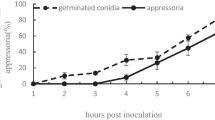Abstract
Halos detected using interference microscopy (even- and fringle-field modes with monoand poly-chromatic light) around penetration sites of Botrytis allii in cell walls of normal and protoplast-free outer epidermal tissue of white, yellow, and red onions were alike. Halos in protoplast-free cell walls contained 33% less dry mass than areas of these walls adjacent to halos (quantitative interference miscroscopy with 546 nm light in the even-field mode). Halos were significantly larger in the white onion than in the yellow and red varieties. The loss of cell wall dry mass during the production of halos involved the loss of pectin and cellulose. We infer that this is caused by enzymes released from the pathogen. Cuticle degradation at penetration sites was not observed.
Similar content being viewed by others
References
Aist JR. Cytology of penetration and infection-fungi. In: Heitefuss R, Williams PH, eds. Physiological plant pathology. Berlin, New York: Springer-Verlag, 1976; 197–221.
Akai S. Recent advance in studying the mechanism of fungal infection in plants. Shokubutsu Byogai Kenkyu 1973; 8:1–60.
Akai S, Kunoh H, Fukutomi M. Histochemical changes of the epidermal cell wall of barley leaves infected by Erysiphe graminis hordei. Mycopathologia 1968; 35:175–180.
Bateman DF, Basham HG. Degradation of plant cell walls and membranes by microbial enzymes. In: Heitefuss R, Williams PH, eds. Physiological plant pathology. Berlin, New York: Springer-Verlag, 1976; 316–355.
Beneke G. Application of interference microscopy to biological material. In: Weid GL, ed. Introduction to quantitative cytochemistry. New York: Academic Press, 1966; 63–92.
Bhattacharya PK, Pappelis AJ. Cytofluorometric study of onion epidermal nuclei in response to wounding and Botrytis allii infection. Physiol Pl Pathol 1982; 21:217–226.
Campbell CL, Huang J, Payne GA. Defense at the perimeter: the outer walls and the gates. In: Horsfall JG, Cowling EB, eds. Plant disease: An advanced treatise. Vol. V. New York: Academic Press, 1980; 103–120.
Corner EJH. Observations on the resistance to powdery mildews. Nw Phytol 1935; 34:180–200.
Edwards HH, Allen PJ. A fine structure of primary infection process during infection of Barley of Erysiphe graminis f. sp. hordei. Phytopathology 1970; 60:1504–1509.
Jensen WA. Botanical histochemistry. San Fransisco: Freeman Co., 1962.
Johansen DA. Plant microtechnique. New York: McgrawHill, 1940.
Kritzman G, Chet I, Gilan D. Spore germination and penetration of Botrytis allii into Allium cepa host. Botanical Gazette 1981; 142:151–155.
Kulfinski FB, Pappelis AJ. Interference microscopy of onion epidermal nuclei in response to three fungal pathogens. Physiol Pl Pathol 1971; 1:489–494.
Kunoh H, Akai S. Histochemical observations of the halo on the epidermal cell wall of barley leaves attacked by Erysiphe graminis hordei. Mycopathologia 1969; 37:113–118.
Kunoh H, Yamamori K, Ishizaki H. Cytological studies of early stages of powdery mildew in barley and wheat. VII autofluorescence at penetration sites of Erysiphe graminis hordei on living barley coleoptiles. Physiol Pl Pathol 1982; 21:373–379.
Lupton FGH. Resistance mechanism of species of Triticum and Aegilops and of amphidiploids between them to Erysiphe graminis DC. Trans Brit mycolog Soc 1956; 39:51–59.
Mankarios AT, Friend J. Polysaccharide-degrading enzymes of Botrytis allii and Sclerotium cepivorum. Enzyme production in culture and the effect of the enzymes on isolated onion cell walls. Physiol Pl Pathol 1980; 17:93–104.
Mayama S, Pappelis AJ. Application of interference microscopy to the study of fungal penetration of epidermal cells. Phytopathology 1977; 67:1300–1302.
McKeen WE. Mode of penetration of epidermal cell walls of Vicia faba by Botrytis cinerea. Phytopathology 1974; 64:461–467.
McKeen WE, Smith R, Bhattacharya PK. Alterations of the host cell wall surrounding the infection peg of powdery mildew fungi. Canad J Bot 1969; 47:701–706.
Nicholson RL, Kuc J, Williams EB. Histochemical demonstration of transitory esterase activity in Venturia inaequalis. Phytopathology 1972; 62:1242–1247.
Pappelis AJ, Pappelis GA, Kulfinski FB. Nuclear orientation in onion epidermal cells in relation to wounding and infection. Phytopathology 1974; 64:1010–1012.
Pelligrini L. Cytological studies on physodes in the vegetative cells of Cytoderma stricta sauvageau (Phaeophyta, Fucales). J Cell Sc 1980; 41:209–231.
Ride JP. Lignification in wounded wheat leaves in response to fungi and its possible role in resistance. Physiol Pl Pathol 1975; 5:125–134.
Ride JP, Pearce RB. Lignification and papilla formation at sites of attempted penetration of wheat leaves by nonpathogenic fungi. Physiol Pl Pathol 1979; 15:79–92.
Rijkenberg FHJ, DeLeeuw GTN, Verhoeff K. Light and electron microscopy studies on the infection of tomato fruits by Botrytis cinerea. Canad J Bot 1980; 58:1394–1404.
Russo VM, Pappelis AJ. Observations of Colletotrichum dematium f. circinans on Allium cepa: halo formation and penetration of epidermal walls. Physiol Pl Pathol 1981; 19:127–136.
Sargent C, Gay JL. Barley epidermal apoplast structure and modification by powdery mildew contact. Physiol Pl Pathol 1977; 11:195–205.
Sherwood RT, Vance CP. Histochemistry of papillae formed in reed canarygrass leaves in response to non-infecting pathogenic fungi. Phytopathology 1976; 66:503–510.
Sherwood RT, Vance CP. Resistance to fungal penetration in Gramineae. Phytopathology 1980; 70:273–279.
Smith G. The haustoria of the Erysipheae. Botanical Gazette 1900; 29:153–184.
Smith HC, Blair ID. Wheat powdery mildew investigations. Ann appl Biol 1950; 37:570–583.
Stewart A, Mansfield JW. The composition of wall, alterations and appositions (reaction material) and their role in the resistance of onion bulb scale epidermis to colonization by Botrytis allii. Pl Pathol 1985; 34:25–37.
Author information
Authors and Affiliations
Rights and permissions
About this article
Cite this article
Shumway, C.R., Russo, V.M. & Pappelis, A.J. Degenerative changes in the epidermal cell wall of Allium cepa caused by Botrytis allii: Loss of dry mass, pectin, and cellulose in halos. Mycopathologia 101, 47–52 (1988). https://doi.org/10.1007/BF00455668
Accepted:
Issue Date:
DOI: https://doi.org/10.1007/BF00455668




